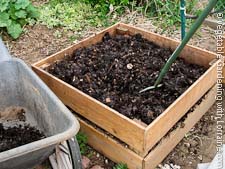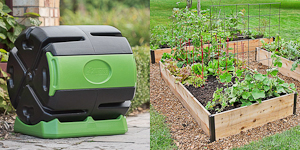- Home
- How to Make Compost
How to Make Compost
Building a Compost Pile That Doesn't Smell
Learning how to make compost properly is actually really fun (IMHO). By knowing a few secrets, you can make compost fairly quickly and without smell. Compost will become one of your most prized "crops", especially when you see the resulting benefits of compost in your vibrant, healthy plants and higher yields. The video walks you through the whole process, and below that is the text version, which covers more detail and has links to other related articles.
Why Compost?
A beautiful and productive vegetable garden is only half of an equation - the half that pulls nutrients and minerals out of the soil for us to eat as vegetables.
Composting and fertilizing together make up the other half of the equation, the half that puts organic matter and nutrients back into the soil. Some people think that compost and fertilizer are the same thing, or that if you put in enough compost, you don't need fertilizer. Both are wrong. Compost and fertilizer do two different things.
Compost feeds the soil microbes, which act like waiters to your plants. They serve up minerals to the plant roots, in exchange for the sugars that the plant makes. Compost also eventually breaks down into humus, which binds mineral nutrients in the soil so they don't wash away, and which makes for light fluffy soil that is easy to work and easy for roots to grow through. It may have some minerals in it, but usually not enough,
Fertilizer is the minerals, the food the plants need to build their bodies.
As our agricultural soils have become depleted of minerals over the years, so has our food. Most compost ingredients, including manure, no longer have sufficient minerals to supply vegetables with nutrition. It is very important now to amend your garden with the appropriate organic fertilizers.
Since compost supplies the organic matter that feeds beneficial microbes and that binds cation nutrients in the soil, it is still important for every vegetable gardener to learn how to make compost. Homemade compost is way better than 99% of commercial composts, which are usually made of waste ingredients like wood chips (= no nutrients), feedlot manure (= antibiotics and growth hormones), and even sewage sludge (= peed-out pharmaceuticals and hormones).
What Can I Put in the Compost?
 How to Make Compost: Choose or Build a Good Bin
How to Make Compost: Choose or Build a Good BinCompost is decayed organic matter, which can include leaves, grass clippings, kitchen vegetable scraps, egg shells, coffee grounds, fall garden refuse and manure (in moderate quantities). Avoid using meat scraps, pet poop or woody twigs because they can (respectively) attract critters, contain pathogens, and be slow to break down.
How to Build the Compost Pile
Before building a compost pile, you may want to read the compost bins review article to help you decide what type of compost bin to buy or build, if you don't have one already.
Compost bins help speed decomposition, help keep critters out, and can actually be an attractive addition to the garden. There are many good ones on the market, but the best one I've ever used I built myself out of fencing cedar from Home Depot. The unique design of this homemade compost bin makes it especially easy to work and turn the compost when necessary, plus it is the most beautiful compost bin I've ever seen.
Whichever bin you use, read through the rest of this page before building your pile so you understand the basics of how to make compost properly. A compost pile that will be odor-free needs a balance of the following:
- "Green" stuff - those materials that are higher in nitrogen, such as fresh grass clippings, vegetable scraps, fresh weeds (preferably without seeds), coffee grounds, etc. These materials aren't necessarily green in color, but they are usually heavier and wetter than "browns".
- "Brown" stuff - materials higher in carbon, such as dried leaves, straw, fall crop wastes, etc. These materials are often brown or straw colored, and are usually light and dry.
- Water
- Air
What constitutes a balance? By volume, you should have about 2-3 times more brown (high carbon) stuff than green (high nitrogen) stuff. The pile should be kept about as moist as a wrung-out sponge. Every once in awhile the pile should be fluffed and mixed up using a garden or hay fork to make sure the lower levels get enough air.
Build the pile in layers - about an inch of vegetable scraps, fresh grass clippings or weeds, then about 3 inches of dried leaves or straw. It's a good idea to have both a compost bin and a wire-sided leaf bin, so that when you get an inch or so of kitchen scraps built up in the compost pile, you have easy access to a couple of bucketfuls of dried leaves to cover them with.
After you add the leaves, mix the layers together a little with a garden or hay fork, and sprinkle some water on it with the hose. Keep layering and mixing like this as the days go by until the compost bin is full, which might take anywhere from 4 weeks to 6 months to fill, depending on how much kitchen and yard waste you generate.
For fastest breakdown and to prevent odor, the pile should be fluffed and mixed every few weeks (or more, for fastest turnaround time). One reason I prefer the bin I built over the big black plastic storebought kind is that accessing the contents is very easy when it's time for mixing or even inverting the pile.
If the pile has the right balance of carbon and nitrogen along with the right balance of water and air, the microbes will go to town eating it up, and the pile will heat up. I have measured temperatures of 160° F at the center of a freshly-made compost pile! This is too hot, though - it's best to keep it below 150° by airing it out if it's getting too hot. Letting it get too hot burns nitrogen out.
If you're still not sure if you want to start your own composting operation, you may like to read Top Ten Myths About Making Compost.
Now that you've learned how to make compost, you can supercharge its benefit to the garden by using some of it to make actively aerated compost tea. After your compost is "finished", or done decomposing, it will be filled with beneficial microorganisms that help the garden in many ways, and are multiplied greatly in the tea.
Final Considerations on How to Make Compost
Troubleshooting
Learning how to make compost isn't rocket science. Don't be intimidated if this article if makes it sound hard! It's not. Compost will happen all by itself even if you do nothing to manage it. It just could take awhile, and might smell bad in the meantime. But even if you don't manage it optimally, the stuff will break down by itself naturally over time.
If the pile does start to smell or it's not breaking down, go to the when compost stinks article for compost troubleshooting tips.
One Bin or Two?
Whether you have one bin or two is not just a matter of volume - it will affect how you process and harvest compost. Two bins are recommended if you have more than a few square feet of garden. One bin will be the "open" bin that you keep adding stuff to, and the other will be the "closed" bin that you have already filled and is in the process of finishing breaking down. If you don't stop adding stuff to a compost pile at some point, you're always going to have un-broken-down stuff in it.
Can't I Just Toss Kitchen Scraps Directly In the Garden?
If you're wondering why you shouldn't just put your vegetable scraps directly on the garden (a logical question), it's because the breakdown process itself will temporarily rob your soil of nutrients. As the hungry fungi and bacteria eat the kitchen scraps, they will temporarily pull the nutrients they need to build their bodies out of the soil, creating a deficiency. When those bacteria later die and their bodies decompose, the nutrients return to the soil. But it's better to do this process in a compost pile or bin.
Knowing how to make compost is an important skill for all vegetable gardeners, but it is especially important if you want to master the art of survival gardening.
I love to make compost. It closes the loop for me, letting me participate in the full cycle of life in the garden. Now that you know how to make compost without smell, I hope you find composting as fun and gratifying as I do!
And if you're looking for a compost pail for your kitchen counter, check out my compost pail buying guide.
Help share the skills and spread the joy
of organic, nutrient-dense vegetable gardening, and please...
~ Like us on Facebook ~
Thank you... and have fun in your garden!
Affiliate Disclaimer
This website contains affiliate links to a few quality products I can genuinely recommend. I am here to serve you, not to sell you, and I do not write reviews for income or recommend anything I would not use myself. If you make a purchase using an affiliate link here, I may earn a commission but this will not affect your price. My participation in these programs allows me to earn money that helps support this site. If you have comments, questions or concerns about the affiliate or advertising programs, please Contact Me.Contact Us Page
Share Your Favorite Compost Bin Design With Us!
Do you have a great compost bin design, or a favorite commercial bin? Share a photo with us, and tell us why you love it.
You Are Here: Vegetable Gardening Home > How to Make Compost







